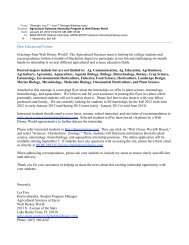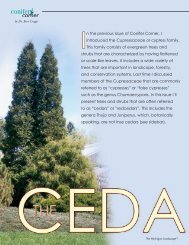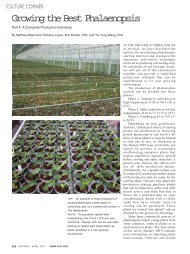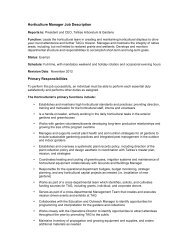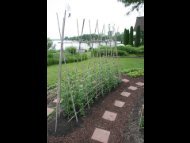Effectiveness of Plant Growth Regulators under Photoselective ...
Effectiveness of Plant Growth Regulators under Photoselective ...
Effectiveness of Plant Growth Regulators under Photoselective ...
You also want an ePaper? Increase the reach of your titles
YUMPU automatically turns print PDFs into web optimized ePapers that Google loves.
Fig. 2. Effect <strong>of</strong> daminozide and GA 3 on plant height <strong>of</strong> ‘Bright Golden Anne’chrysanthemums grown <strong>under</strong> photoselective greenhouse covers with variousphytochrome photoequilibrium estimates (φ e). Vertical bars indicate ±SE (n =12). If the vertical bars are not seen, SE was smaller than the symbol. Lines werefitted to y = β 0 + β 1x, where y is height and x is (φ e – 0.72). Intercept (β 0)represents plant ht. inside the control chamber (φ e <strong>of</strong> 0.72). Predicted regressionequations are: water, height = 34.3 b - 96.1 A x, r 2 = 0.99; daminozide, height =19.5 c – 36.8 B x, r 2 = 0.99; GA 3 , height = 44.5 a – 76.6 A x, r 2 = 0.90; daminozide +GA 3 , height = 43.6 a – 97.4 A x, r 2 = 0.97. Intercepts (β 0 ) and slopes (β 1 ) with samesuperscripted letter (lowercase and uppercase, respectively) are not significantlydifferent at P = 0.05.determine the responsiveness to GA 3 when endogenous GAsupply was blocked.<strong>Plant</strong>s were fertilized three times a week at irrigation with 1g·L –1 <strong>of</strong> a 20N–4.4P–16.7K water soluble fertilizer (Peters 20–10–20 Peat-Lite Special, Scotts-Sierra Horticultural ProductsCo., Marysville, Ohio). <strong>Plant</strong>s in all chambers received an averagedaily PPF integral <strong>of</strong> 15.5 ± 0.3 mol·m –2 on a clear day. Dailymaximum and minimum air temperatures inside chambers wererecorded during the experiment. Average daily maximum (30 ±2 °C) or minimum (20 ± 1°C) temperatures during the experimentalperiod were not different among chambers.EXPERIMENT 2: PLANT RESPONSE TO EARLY AND LATE GA INHIBI-TORS UNDER HIGH φ e . <strong>Plant</strong> response to paclobutrazol [earlyinhibitor <strong>of</strong> GA biosynthesis, Coolbaugh and Hamilton, 1976)]and prohexadione-Ca [late inhibitor <strong>of</strong> GA biosynthesis (Brownet al., 1997)] was evaluated inside control (φ = 0.72) and YBM-1 no. 55 (φ = 0.83) chambers. Chrysanthemums were grown asdescribed previously. After a 1-week establishment period, 48plants were transferred to each chamber. A set <strong>of</strong> six plants in eachchamber was treated with one <strong>of</strong> the following eight treatments:1) GA 1 at 50 µg per apex (Sigma Chem. Co., St. Louis, Mo.) asa 10 µL drop to the apex, 2) paclobutrazol (PA) at 0.73 mg activeingredient (a.i.) per pot as a 10-mL soil drench (Bonzi, UniroyalChem. Co), 3) prohexadione-Ca (PR) at 200 mg·L –1 a.i. as foliarspray (BAS 125 10W, BASF Corp., ResearchTriangle Park, N.C.), 4) combination<strong>of</strong> paclobutrazol at 0.73 mg a.i. andprohexadione-Ca at 200 mg·L –1 a.i (PA +PR), 5) combination <strong>of</strong> paclobutrazol at0.73 mg a.i. and GA 1 at 50 µg (PA + GA 1 ),6) combination <strong>of</strong> prohexadione-Ca at 200mg·L –1 a.i. and GA 1 at 50 µg (PR + GA 1 ), 7)combination <strong>of</strong> paclobutrazol at 0.73 mga.i., prohexadione-Ca at 200 mg·L –1 a.i., andGA 1 at 50 µg (PA + PR + GA 1 ), and 8) wateronly (control). <strong>Plant</strong>s were treated on theday <strong>of</strong> transfer to the growth chambers and,again, after 2 weeks in the chambers. GA 1was dissolved in 95% ethanol, diluted withwater to 50% ethanol and was applied as a10-µL drop to the apex using a syringe. Forthe combination treatments, plants were pretreatedwith the respective growth retardantas described before GA 1 application. A separateset <strong>of</strong> six control plants was treated with50% ethanol and the height <strong>of</strong> controls didnot differ. <strong>Plant</strong>s in experimental chambersreceived an average daily PPF integral <strong>of</strong>14.1 ± 0.5 mol·m –2 on a clear day.EXPERIMENTAL DESIGN AND ANALYSIS. Experimentalchambers were randomly positionedinside a glass greenhouse. Because <strong>of</strong> the limited number<strong>of</strong> chambers, experiments were repeated once to replicate. Theexperimental design was a randomized complete block designwith a split-plot arrangement <strong>of</strong> the treatments. The light treatment(φ e ) was the main plot factor and the growth regulatortreatments were the subplots. The blocking factor for the experimentwas the replicate. Sets <strong>of</strong> six plants were the experimentalunits for the subplot factor and groups <strong>of</strong> growth regulatortreatment (four for expt. 1 and eight for expt. 2) were theexperimental units for the whole plot factor.<strong>Plant</strong> height (distance from the medium surface to shoot apex)was measured for 4 weeks at weekly intervals. The number <strong>of</strong>fully expanded leaves was counted, and leaf and stem dry weights(DWs) were taken at termination. Average internode length wasdetermined as height/number <strong>of</strong> leaves. For DW measurements,shoots were oven-dried for 5 d at 85 °C.Data from the experiment were analyzed using analysis <strong>of</strong>variance procedures <strong>of</strong> the PROC MIXED <strong>of</strong> SAS (SAS Inst.,Inc., Cary, N.C.). The φ e factor was evaluated by linear, quadratic,cubic, and quadratic contrasts. Polynomial regression modelswere fit to the data using contrasts. Powers <strong>of</strong> (φ e – 0.72) were usedso that the intercept term would represent the mean for the controllight treatment value <strong>of</strong> φ e (0.72). Comparisons <strong>of</strong> polynomialcoefficients for the different growth regulator treatments weredone using pairwise t tests.ResultsRESPONSE TO DAMINOZIDE AND GA 3 UNDER PHOTOSELECTIVECOVERS WITH VARIOUS φ e . <strong>Plant</strong> height decreased linearly (P
Number <strong>of</strong> leaves was not affected by φ e or the growth regulatortreatment (data not presented). Internode length responded toincreasing φ e in a similar pattern to that <strong>of</strong> height and growthregulator treatments (data not presented).Dry matter accumulation was influenced by the photoselectivecovers and the growth regulator treatment (Fig. 3). Table 2represents the regression coefficients <strong>of</strong> fitted lines in Fig. 3 andthe significance <strong>of</strong> slopes at P < 0.05. Leaf dry matter accumulationdecreased as φ e increased, except for GA 3 -treated plantswhich had similar leaf DW at all φ e . Leaf DW <strong>of</strong> water anddaminozide + GA 3 -treated plants decreased linearly as the φ eincreased while that <strong>of</strong> daminozide treatment followed a quadraticpattern. Stem DW <strong>of</strong> control (water) and daminozidetreated plants decreased linearly as the φ e increased. The rate <strong>of</strong>decrease was greater in control plants (greater β 1 , Table 2) than indaminozide treated plants. Total shoot DW <strong>of</strong> water and GA 3 -treated plants decreased linearly while in daminozide treatedplants it followed a quadratic trend. Overall, plants that receivedGA 3 or daminozide + GA 3 had greater DW. Specific stem DW(stem DW per unit length) or specific leaf DW (leaf DW per unitarea) was not affected (data not presented), indicating that thedecreased DW was mainly a result <strong>of</strong> smaller plants (data notpresented).EFFECTIVENESS OF EARLY AND LATE GA BIOSYNTHESIS INHIBI-TORS. Both paclobutrazol and prohexadione-Ca resulted in shorterplants in control (φ e = 0.72) and YBM-1 no. 55 (φ e = 0.83)chambers (Fig. 4), but the height reduction by paclobutrazol wasmore than that <strong>of</strong> prohexadione-Ca. The combination <strong>of</strong>paclobutrazol and prohexadione-Ca reduced plant height morethan either <strong>of</strong> them alone. Exogenous GA 1 increased plant heightover the water-treated control in both light environments. GA 1treatment reversed height reduction caused by paclobutrazol andprohexadione-Ca in plants grown in control and YBM-1 chambers.The height increase by GA 1 was greater when it was appliedwith prohexadione-Ca than when it was applied with paclobutrazolor alone. There was no significant interaction between the plantgrowth regulator and φ e treatments.DiscussionFig. 3. Effect <strong>of</strong> daminozide and GA 3 on (A) leaf, (B) stem, and (C) total dryweight <strong>of</strong> ‘Bright Golden Anne’ chrysanthemums grown <strong>under</strong> greenhousecovers with various phytochrome photoequilibrium estimats (φ e ).<strong>Photoselective</strong> covers with high φ e reduced height <strong>of</strong> ‘BrightGolden Anne’ chrysanthemums without use <strong>of</strong> chemical growthretardants. In separate studies, the height <strong>of</strong> several vegetable andornamental crops was also reduced by photoselective greenhousecovers, indicating that photoselective covers are effective for awide range <strong>of</strong> crops (Rajapakse et al., 1999). The linear relationshipbetween plant height and φ e (Fig. 2) in this study suggests thateffectiveness <strong>of</strong> photoselective covers increases as φ e is increased.The PPF transmission <strong>of</strong> photoselective covers decreasesas the φ e increases because <strong>of</strong> the increasing dye concentration.Identifying photoselective covers that effectively filterout FR light from sunlight and reduce plant height while minimizingthe PPF reduction is critical for commercial success <strong>of</strong>photoselective covers. Our data indicate that photoselective coverswith φ e <strong>of</strong> 0.78 (which corresponds to ≈25% PPF reduction)was effective in achieving a 20% to 30% height reduction <strong>of</strong>chrysanthemum (Oi et al., 1998; Rajapakse et al., 1998; Rajapakseet al., 1999).Gibberellins are known to stimulate stem elongation <strong>of</strong> manyplant species. The change in stem elongation in response tochanges in R and FR light in the environment has been reportedto be mediated by changes in gibberellin levels due to reducedsynthesis (Morgan et al., 1980) or increased destruction (Lockhart,1959), or by reduced responsiveness <strong>of</strong> plants to gibberellins676 J. AMER. SOC. HORT. SCI. 125(6):673–678. 2000.
Table 2. Regression coefficients <strong>of</strong> fitted lines for the relationship between leaf, stem or total DWs <strong>of</strong> ‘Bright Golden Anne’ chrysanthemums andphytochrome photoequilibrium estimates (φ e). Y = β 0+ β 1(φ e– 0.72) + β 2(φ e– 0.72) 2 .Estimated regression coefficientsTreatment β 0β 1β 2LeafWater 2.0 a z –3.60 b 0Daminozide 2.1 a –13.2 a 85.3GA 31.9 a 0 0Daminozide + GA 32.0 a –3.3 b 0StemWater 1.4 b –5.0 b 0Daminozide 0.8 c –2.5 c 0GA 31.8 a –4.2 bDaminozide + GA 32.0 a –14.5 a 75.5TotalWater 3.5 bc –8.8 b 0Daminozide 3.0 c –19.0 a 112.6 aGA 33.8 ab –5.42 b 0Daminozide + GA 34.1 a –24.6 a 134.6 az Mean separation within columns for a tissue factor by pairwise t test at P = 0.05.(Reid and Ross, 1988). It is possible, therefore, that photoselectivecovers reduce plant height by altering the gibberellin metabolismor the responsiveness. In the current experiments, both exogenousGA 1 and GA 3 reversed the height reduction caused by thephotoselective covers with high φ e . Our results with exogenousGA 3 or GA 1 application indicate that responsiveness to gibberellinswas not reduced in plants grown <strong>under</strong> photoselective panelswith high φ e . It is possible that gibberellin levels may have beenreduced in plants grown <strong>under</strong> high φ e environments.Our quantification studies (unpublisheddata) indicated that GA 19 levelswere higher and GA 1 levels were lower inchrysanthemum plants grown <strong>under</strong> CuSO4filters which had a φ e <strong>of</strong> 0.81. In addition,metabolism <strong>of</strong> radiolabelled GA 19 was slowerin CuSO4-filter-grown plants than in controlplants (unpublished data). These observationssuggest that suppression <strong>of</strong> gibberellinbiosynthesis may be the cause for reducedheight <strong>under</strong> FR light depleted environments.Martinez-Garcia and Garcia-Martinez (1992) reported that FR light-inducedstem elongation <strong>of</strong> cowpea [Vignasinensis (L.)] was related to increased levels<strong>of</strong> GA 1 . Campbell and Bonner (1986) reportedthat conversion <strong>of</strong> GA 20 (inactive) toGA 1 (active), occurs readily in dark-growndwarf pea (Pisum sativum L.) seedlings andthis conversion is prevented by R light.Most chemical growth retardants, includingthe ones tested herein, reduce stem elongationby blocking gibberellin biosynthesis(Brown et al., 1997; Coolbaugh andHamilton, 1976). If the mode <strong>of</strong> action <strong>of</strong>photoselective films were to block GA biosynthesis,plants treated with daminozidewould not have responded <strong>under</strong> the high φenvironment. In the present experiment,daminozide treatment further reduced the height <strong>of</strong> plants grown<strong>under</strong> photoselective covers indicating that the covers were not aseffective as daminozide in blocking GA biosynthesis. The mag-Fig. 4. Weekly height increase <strong>of</strong> ‘Bright Golden Anne’ chrysanthemums grownin (A) control or (B) YBM-1 no. 55 chambers in response to prohexadione-Ca(PR), paclobutrazole (PA), and GA 1 application. Vertical bars indicate ±SE (n =12). If the vertical bars are not seen, SE was smaller than the symbol.J. AMER. SOC. HORT. SCI. 125(6):673–678. 2000.677
nitude <strong>of</strong> height reduction caused by daminozide decreased as φ e<strong>of</strong> the growing environment increased (Fig. 2), suggesting thatGA biosynthesis may be progressively reduced as φ e increases.Both paclobutrazol and prohexadione-Ca were effective incontrolling plant height <strong>under</strong> a photoselective cover with high φ e ,but paclobutrazol was more effective than prohexadione-Ca inreducing stem elongation (Fig. 4). The difference in effectivenessbetween the two compounds could be due to different modes <strong>of</strong>action. Paclobutrazol blocks an early step in the gibberellinbiosynthetic pathway [oxidation <strong>of</strong> ent-kaurene to GA 12(Coolbaugh and Hamilton, 1976)], whereas prohexadione-Cablocks a late step in the pathway [3β-hydroxylation <strong>of</strong> GA 20 toGA 1 (Brown et al., 1997)]. Prohexadione-Ca has been also shownto prevent metabolism <strong>of</strong> GA 1 to inactive GA 8 by blocking the 2βhydroxylation(Brown et al., 1997).Exogenous GA 1 promoted growth <strong>of</strong> paclobutrazol orprohexadione-Ca-treated plants regardless <strong>of</strong> the light environment.This also shows that the shorter plants <strong>under</strong> thephotoselective cover were not a result <strong>of</strong> reduced sensitivity togibberellins. Maas and van Hattum (1998) reported thatpaclobutrazol-treated fuchsia (Fuchsia ×hybrida Hort. ex Vilm.)plants showed a similar response to exogenous GA 1 when grownat higher night temperatures than day temperatures (–DIF) or athigher day temperatures than night temperatures (+DIF). Theyalso reported that response to GA 1 was similar <strong>under</strong> white ororange light regardless <strong>of</strong> the temperature regime. Their datasuggested that the differences in shoot elongation they observed<strong>under</strong> various light and temperature conditions did not result fromlight quality or day/night temperature mediated changes in plantsensitivity to GA 1 . Assuming that these growth retardants blockGA biosynthesis, the additional height reduction by growthretardants <strong>under</strong> photoselective covers suggests that gibberellinbiosynthesis may not be the only height controlling mechanism<strong>under</strong> photoselective covers.When applied together with prohexadione-Ca, GA 1 in theplant may be sustained for a longer period thereby increasing plantheight greater than treatment with GA 1 alone (Fig. 4). Recent workby Ait–Ali et al. (1999) has shown that exposure <strong>of</strong> etiolated peaseedlings to white light decreased GA 1 levels due to increased 2βhydroxylaseactivity. Their results show that light-enhanced degradation<strong>of</strong> GA 1 plays a role in reduced stem elongation when darkgrown plants are transferred to light. If photoselective coversenhance metabolism <strong>of</strong> GA 1 to GA 8 , the response to exogenous GA 1and the combination <strong>of</strong> prohexadione-Ca and GA 1 should have beensmall <strong>under</strong> photoselective covers. GA 1 increased the height <strong>of</strong>plants grown <strong>under</strong> photoselective covers and when applied withprohexadione-Ca, height increase was greater than GA 1 alone,indicating that the increased metabolism <strong>of</strong> GA 1 to GA 8 did notcause height reduction by photoselective covers.In summary, our results show that photoselective greenhousecovers with high φ e controlled height <strong>of</strong> greenhouse-grown ‘BrightGolden Anne’ chrysanthemums without chemical growth retardants.<strong>Photoselective</strong> covers with φ e <strong>of</strong> 0.78 were effective inachieving ≈20% height reduction without chemical growth regulators.In the present work, experimental chambers were kept insidea glasshouse so that the PPF reduction was greater than if thephotoselective covers were used as the primary cover. If thephotoselective covers were used as the primary greenhouse cover,then the covers with higher φ e than 0.78 may still provide sufficientPPF to grow a satisfactory crop, especially in southern latitudeswhere irradiance is high. Results also suggest that gibberellins areat least partially involved in height reduction induced byphotoselective covers. <strong>Photoselective</strong> greenhouse covers did notreduce the responsiveness to gibberellins, and it appears that themechanism may be to suppress gibberellin biosynthesis.<strong>Photoselective</strong> covers were not as effective as chemical growthretardants in suppressing gibberellin biosynthesis.Literature CitedAit-Ali, T., S. Frances, J.L. Weller, J.B. Reid, R.E. Kendrick, and Y.Kamiya. 1999. Regulation <strong>of</strong> GA 20-oxidase and GA 3β-hydroxylasetranscript accumulation during phytochrome-mediated de-etiolation<strong>of</strong> pea seedlings. <strong>Plant</strong> Physiol. 121:783–791.Brown, R.G.S, H. Kawaide, Y. Yang, W. Rademacher, and Y. Kamiya.1997. Daminozide and prohexadione-Ca have similar modes <strong>of</strong> actionas inhibitors <strong>of</strong> the late stages <strong>of</strong> gibberellin metabolism. Physiol. <strong>Plant</strong>.101:309–313.Campell, B.R. and B.A. Bonner. 1986. Evidence for phytochromeregulation <strong>of</strong> gibberellin A 203β-hydroxylation in shoots <strong>of</strong> dwarf (lele)Pisum sativum L. <strong>Plant</strong> Physiol. 82:909–915.Coolbaugh, R.C. and R. Hamilton. 1976. Inhibition <strong>of</strong> ent-kaureneoxidation and growth by α-cyclopropyl-α-(p-methoxy-phenyl)-5-pyrimidinemethyl alcohol. <strong>Plant</strong> Physiol. 57:245–248.Hayward, P.M. 1984. Determination <strong>of</strong> phytochrome parameters fromradiation measurements, p. 159–173. In: H. Smith and M.G. Holms(eds.). Techniques in photomorphogenesis. Academic Press, London.Lockhart, J.A. 1959. Studies on the mechanism <strong>of</strong> stem growth inhibitionby visible radiation. <strong>Plant</strong> Physiol. 34:457–460.Maas F.M. and J. van Hattum. 1998 Thermomorphogenic and photomorphogeniccontrol <strong>of</strong> stem elongation in fuchsia is not mediated bychanges in responsiveness to gibberellins J. <strong>Plant</strong> <strong>Growth</strong> Regul.17:39–45.Martinez-Garcia, J. and J.L. Garcia-Martinez. 1992. Phytochrome modulation<strong>of</strong> gibberellin metabolism in cowpea epicotyls, p. 585–590. In:C.M. Karssen, L.C. van Loon, and D. Vreugdenhil. (eds.). Progress inplant growth regulation. Kluwer Academic Publishers, Dordrecht, TheNetherlands.Morgan, D.C., T. O'Brien, and H. Smith. 1980. Rapid photomodulation<strong>of</strong> stem extension in light-grown Sinapis alba L. Studies on kinetics,site <strong>of</strong> perception and photoreceptor. <strong>Plant</strong>a 150:95–101.Morgan, D.C. and H. Smith. 1976. Linear relationship between phytochromephotoequilibrium and growth in plants <strong>under</strong> simulated naturalradiation. Nature 262:210–212.Morgan, D.C. and H. Smith. 1979. A systematic relationship betweenphytochrome-controlled development and species habitat, for plantsgrown in simulated natural radiation. <strong>Plant</strong>a 145:253–258.Oi, R., N. Arai, Y. Matsuzaki, K. Seino, O. Kohgo, S. Ikado, M. Iwata,and K. Murakami. 1998. <strong>Photoselective</strong> plastics and their effects onplant growth. Proc. Natl. Agr. Plastics Congr. 27:35–40.Rajapakse, N.C. and J.W. Kelly. 1992. Regulation <strong>of</strong> chrysanthemumgrowth by spectral filters. J. Amer. Soc. Hort. Sci. 117:481–485.Rajapakse, N.C., R.E. Young, M.J. McMahon, and R. Oi. 1999. <strong>Plant</strong>height control by photoselective filters: Current status and futureprospects. HortTechnology 9:618–624.Rajapakse, N.C., R.E. Young, and R. Oi. 1998. <strong>Plant</strong> growth regulationby photoselective greenhouse covers. Proc. Natl. Agric. Plastics Congress27:23–29.Reid, J.B. and J.J. Ross. 1988. Internode length in Pisum. A new gene,lv, conferring an enhanced response to gibberellin A1. Physiol. <strong>Plant</strong>.72:595–604.Sager, J.C., W.O. Smith, J.C. Edwards, and K.L. Cyr. 1988. Photosyntheticefficiency and phytochrome equilibria determination using spectraldata. Trans. Amer. Soc. Agr. Eng. 31:1882–1887.678 J. AMER. SOC. HORT. SCI. 125(6):673–678. 2000.



